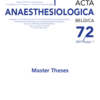Comparing the impact of OFA (opioid free anesthesia) and steroids on the quality of recovery after Hip Arthroplasty by Direct Anterior Approach Using Minimally Invasive Surgery: a case-control study
Anesthesia and analgesia; Enhanced Recovery After Surgery (ERAS); Total Hip Arthroplasty (THA)
Published online: Apr 21 2022
Abstract
The direct anterior approach (DAA), a hip replacement method is less invasive showing superior early outcomes than in other approaches, both in terms of reduced pain and improved mobility. Our hypothesis is that patients undergoing total hip arthroplasty with direct anterior approach, who had OFA in combination with Methylprednisolone have a substantial lower CRP postoperative, a better quality of recovery and less use of opioids peri-operative than the control group. A case control study with 41 patients undergoing DAA were included. The study group got a classic OFA with high dose metylprednisolone 125 mg. A classic opioid anesthesia was used in the control group without the corticoid. A linear regression is used to evaluate the independent effect of the study group next to the effect of age/BMI/ASA/gender on morphine peri-operative used, QoR15 and CRP after 24h. Dindoo-Clavien score, PONV and length of hospital stay were evaluated secondary. Only BMI differed in the demographic characteristics between both groups, it was higher in the control group. OFA & steroids patients recovered better with lower CRP (11,5±3,0 vs 35±12,9 mg/dL; p=0,002) and higher QoR15 (127±7 vs 112±10; p=0,019) while getting a lower total dose of opioids peri-operative (5,2±2,1 vs 31,5±6,1 mg; p<0,001). In a linear regression analysis OFA & steroids was the only independent factor improving the quality of recovery and reducing the peri- operative opioids for the same VAS score. The CRP was independent lower in patients getting an OFA & steroid. OFA and high dose steroids improve quality of recovery with lower CRP.
